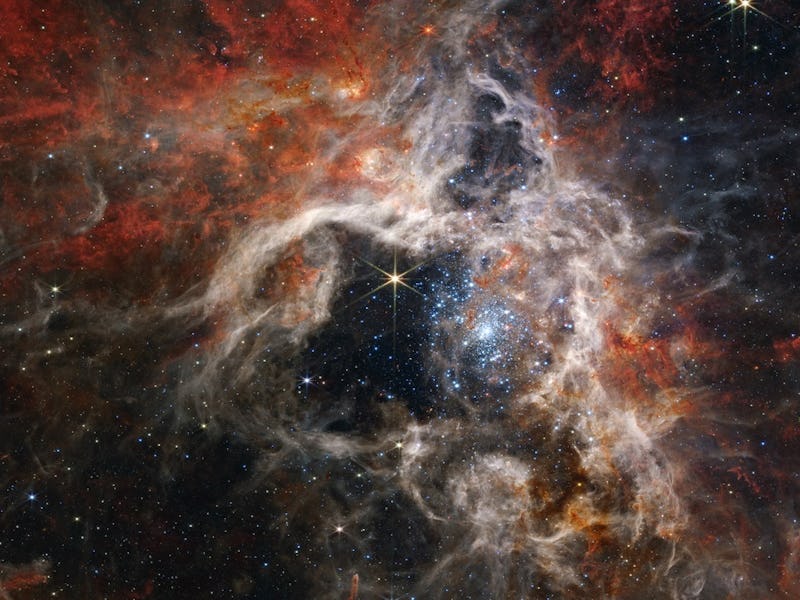Look! Stunning new Webb image of the Tarantula Nebula is an early Halloween treat
Space spiders eat the space insects in your house

Just in time to kick off Spooky Season, the James Webb Space Telescope brings us this eerily gorgeous full-color image of the Tarantula Nebula.
It looks like a hulking cosmic spider lurking amid the stars of the Large Magellanic Cloud, a nearby galaxy — at least in the wavelengths of light our eyes can see. In the longer wavelengths of infrared light, the clouds of gas and dust look more like a tarantula’s burrow, lined with spider-silk.
And like a tarantula’s burrow, the Tarantula Nebula (more formally known as 30 Doradus) is full of young waiting to be born. Perhaps fortunately for all of us, it’s massive, bright young stars — not hungry baby space spiders — that are preparing to burst free from the silken filaments of their nurseries.
Step into my parlor, said the spider — The Tarantula Nebula, located 161,000 light years away in a nearby dwarf galaxy called the Large Magellanic Cloud, is home to thousands of young stars — some newborn and blazing, others still forming in their cocoons of dust.
Its clouds of gas and dust make up the largest and brightest region of star formation in our whole neighborhood of nearby galaxies, the Local Group (which includes, among others, our Milky Way, Andromeda, and the Large Magellanic Cloud). And the Tarantula Nebula is home to the brightest, and most massive stars astronomers have ever discovered.
This is what the Tarantula Nebula looks like in visible light, courtesy of the Hubble Space Telescope. Giant space spider or glowing kaiju crab?
It also looks like it belongs in our universe’s distant past, not a modern nearby galaxy. When the universe was just a few billion years old, giant regions of gas and dust churned out hot, bright, massive stars at a dazzling rate. Cosmologists call this period “cosmic noon,” partly because of the brilliant light of all those newborn stars — most of which have since burned themselves out and died in fiery supernovae, as massive stars tend to do.
Star-forming regions in distant galaxies, whose light left them during the heady days of Cosmic Noon, have a slightly different chemical makeup than the stellar nurseries of more recently-formed galaxies like our Milky Way. And it’s probably no coincidence that star-forming nebulae here in the Milky War produce new stars at a much slower rate than those older, enormous nebulae.
But the Tarantula Nebula is birthing new stars at a dazzling rate, and its chemical composition looks more like something from Cosmic Noon than the modern era.
“Webb will provide astronomers the opportunity to compare and contrast observations of star formation in the Tarantula Nebula with the telescope’s deep observations of distant galaxies from the actual era of Cosmic Noon,” writes the Space Telescope Science Institute, or STScI, the organization that manages Webb, in a statement.
This NIRCam image was created by assigning a visible color to each wavelength of infrared light.
Newborn stars in the tarantula’s burrow — In this image from Webb’s Near InfraRed Camera, or NIRCam, a dark cavity lurks in the center of the nebula, as if daring unwary explorers to step inside the spider’s burrow.
In this cavity, a cluster of massive young stars have carved out the heart of the nebula with their blazing stellar winds. You can see them glowing pale blue in the NIRCam image. And if you stare into the darkness, you can see all the way through the nebula to distant galaxies in the background of the image.
Pillars of gas and dust around the edges of the cavity are pockets of material packed together densely enough to resist erosion — similar to how rock pillars and arches form here on Earth. In their depths, they contain still-growing protostars that will eventually gather enough mass to flare to life and begin sculpting the nebula around them with their own stellar winds.
This MIRI image shows the Tarantula Nebula in slightly longer wavelengths, highlighting different features than the NIRCam image.
You can’t see those protostars in the NIRCam image, but they show up in the slightly longer wavelengths captured by Webb’s Mid InfraRed Instrument, or MIRI. Because those wavelengths can pierce through dust clouds, MIRI reveals the soft glow of protostars embedded in the nebula’s pillars.
And although Webb’s Near InfraRed Spectrometer, or NIRSpec, doesn’t produce images that we can see (it captures spectra — the unique wavelengths of light emitted and absorbed by different molecules, like a chemical fingerprint in light), it can still tell fascinating stories. Deep in the Tarantula Nebula, NIRSpec caught one newborn star just emerging from its dust-pillar cocoon, still shrouded by a small cloud of dust.
“Without Webb’s high-resolution spectra at infrared wavelengths, this episode of star formation-in-action could not have been revealed,” writes STScI.
This article was originally published on